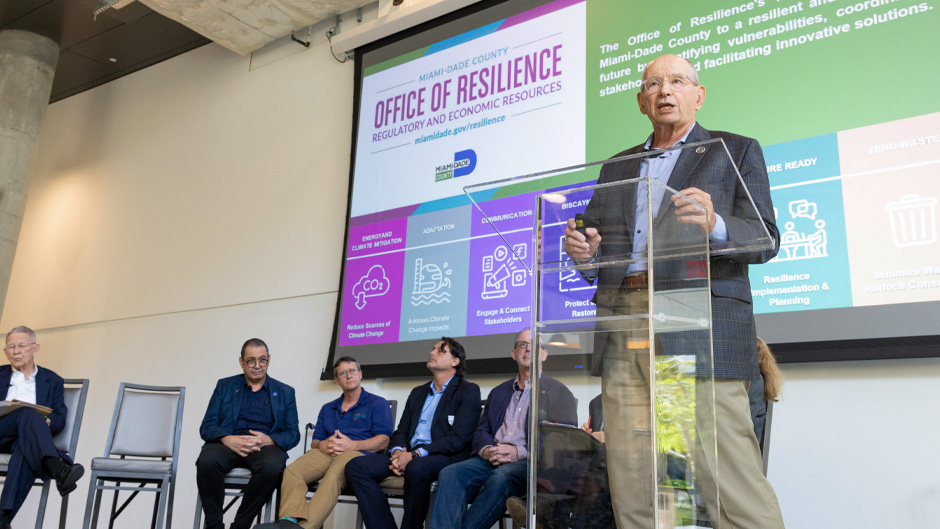It’s the children who suffer the most.
For many of them, the harmful effects of climate change such as rising temperatures, poor air quality, and water scarcity can be too much for their still-developing bodies to handle, putting them at a higher risk for contracting respiratory conditions and falling victim to vector-borne diseases like dengue fever and malaria.
“And kids in underserved populations across the world face the greatest burden. They are 10 times more likely to be affected by those adverse climate events,” said Lisa Gwynn, associate professor of clinical pediatrics at the University of Miami Miller School of Medicine and medical director of the Pediatric Mobile Clinic.
Gwynn was among the more than 25 experts in fields ranging from medicine, public health, and law to architecture, engineering, and atmospheric science who spoke and presented research Friday on the societal and health impacts of climate change during the University’s sixth Climate and Health Symposium.
Clinical practices to address the health impacts of climate change; the increasing burden of trauma and injury because of climate change and natural disasters; trends in Atlantic hurricane activity and landfalls; strategies to advance resilience through the built environment; and civil rights remedies to address housing displacement and racial resegregation were just some of the topics discussed.
South Florida, often described as ground zero for sea level rise, is especially vulnerable to the impacts of climate change, Jeffrey Duerk, executive vice president for academic affairs and provost, said in opening the daylong summit. “Our natural and built environments continuously face evolving threats. The University of Miami serves as a living lab building capacity and intellectual power to address these local and global challenges to build a more resilient environment.”
He noted the University’s Climate Resilience Academy as one of the most effective strategies that has been implemented to foster solutions to climate change. More than 85 projects across a multitude of schools and colleges are addressing climate and related resilience issues as part of the new initiative, with industry, government, and other stakeholders partnering in some of those activities.
Miami-Dade County Mayor Daniella Levine Cava echoed many of Duerk’s sentiments, calling South Florida a subtropical coastline community that feels the effects of climate change before much of the rest of the world. “The climate crisis is arriving on our shores earlier than most, so we must innovate in real time to fight back,” she said.
Saying that her administration is “literally writing the climate bible that may be used around the world in this century,” Cava noted new county initiatives such as a Building Efficiency 305 program aimed at increasing energy and water efficiency in large public and private structures, and the Connect 2 Protect in which sewer services are being extended to residents still using septic systems.
“As the seas rise and the water table rises, these failing tanks are leaking waste directly into our water supply and into our bay,” she said. “Many of these tanks are in the lowest income communities. These are places where residents cannot afford the massive cost of conversion. So, we’re working with our cities, and we’re educating people on the need for conversion.”
Held at the Lakeside Village Expo Center and cohosted by the Climate Resilience Academy and the Master of Science in Climate and Health graduate program, the symposium could not have been more timely, serving as a prelude of sorts to an April 10 Washington Post news story that reports on an unusual upsurge in sea levels along the U.S. Gulf and southeastern coasts since 2010, raising concerns that coastal cities like Miami are much more vulnerable to the effects of rising seas than previously thought.
The Engineering Coastal Resilience Through Hybrid Reef Restoration, or ECoREEF, project is one example of the University’s major efforts to protect coastlines from sea level rise and storm surge as well as to restore coral reefs. As part of that project, a team of scientists from the College of Engineering and Rosenstiel School of Marine, Atmospheric, and Earth Science recently sunk 27 interlocking concrete structures to form two hybrid reef units 1,000 feet offshore of North Beach Oceanside Park, at the northern edge of Miami Beach.
Researchers and public health scientists at the symposium agreed that curbing the negative health impacts of climate change is critical. But solutions must be equitable and “meet the needs of all people, not just some,” Gwen Collman, director of the Office of Scientific Coordination, Planning, and Evaluation at the National Institute of Environmental Health Sciences, cautioned in her keynote address.
“This symposium is much more than informing about the problem. It’s about solutions,” said Naresh Kumar, professor of public health sciences at the Miller School, who came up with the idea for the conference and has taken the lead in organizing it every year since it started.
Noting that the Pediatric Mobile Clinic she leads was created in response to Hurricane Andrew more than 30 years ago, Gwynn said the 38-foot van, which includes telehealth capabilities in all its exam rooms, continues to provide much-needed health care to children in communities disproportionately impacted by climate change.
“When we are in a disaster, we are well-equipped to handle any type of basic medical condition in children,” Gwynn said. “And we’re always going to be at the table to provide mobile health care in times of crisis and disaster.”

